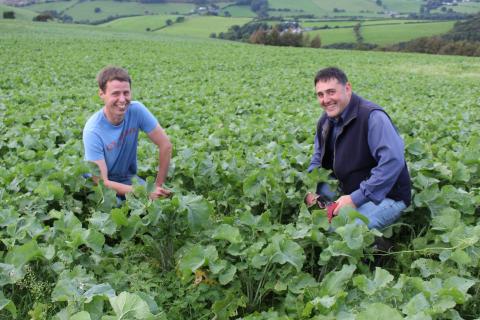With the majority of ewe sales completed, many farmers will now be focusing on the winter feeding of the flock.
Reducing the burden of feed costs as well as tackling lameness are key strategies being adopted at a Farming Connect Demonstration Farm to improve winter management.
In an effort to reduce his winter feed bill and ease pressure on spring grazing, Rhidian Glyn, of Rhiwgriafol, Talywern, Machynlleth will be outwintering 250 ewes on swedes on his 530-acre hill farm.
“The idea is that there won’t be stock on most of the fields over the winter so I can lamb onto quality grass in the spring,” Rhidian told farmers at a Farming Connect open event.
Swedes are a traditional winter crop, with an energy of around 12ME and 10% protein. Grassland expert Charlie Morgan, who is working with Rhidian on the project, has calculated that the swedes will yield about eight tonnes dry matter per hectare and provide more than three months of grazing.
“The crop is going to feed the ewes for about five pence a day, but if they’re in the shed they will cost around 15p per day. Saving 10p per ewe for 90 days on 250 animals is quickly going to add up,” said Mr Morgan. “We’re trying to reduce costs by shortening the winter as much as we can. Growing crops like this can improve winter carrying capacity, it is cheaper and you’re also improving the ground.”
The swedes will be strip grazed with an electric fence to optimise utilisation and a softer variety is being used to protect the ewes’ teeth. As swedes can be low in some trace elements, minerals will also be provided and the sheep will have a runback to a neighbouring field to prevent them becoming too wet and dirty and offer extra grazing.
Another important task at Rhiwgriafol starting this autumn is tackling lameness in the flock. Rhidian is working on a project with his vet Rhian Davies and Farming Connect technical officer Catherine Nakielny to implement the five-point plan for lameness. Developed between researchers and farmers, following the five-point plan can reduce lameness to less than 5% in the first year. The five steps to lameness control are:
- Treat: Rapid treatment helps stop the cycle of infection.
- Avoid: Reduce opportunities for disease to spread between sheep via the ground.
- Vaccinate: Vaccination improves individual immunity.
- Cull: An aggressive culling policy is critical in the first year of the plan to remove sources of infection from the flock.
- Quarantine: Prevent bringing in problems with new sheep to protect existing ewes and newcomers.
Vet Rhian Davies said: “We need to tackle lameness due to the production losses and costs in terms of management and welfare.”
Rhian advised working out what percentage of the flock are lame as well as correctly identifying the cause. Contagious Ovine Digital Dermatitis (CODD) is the main problem at Rhiwgriafol, where at one point this autumn about 15% of the ewes were lame. The other two main causes of lameness in sheep are footrot and scald, with high risk periods for lameness in late summer before tupping and at housing.
When dealing with a group of lame ewes Rhian suggested footbathing, injecting the worst affected and isolating from the main flock. Treated ewes should be left for a week before repeating the treatment if still lame. In the third week the group may just need footbathing, but if any are still lame consider whether the correct treatments are being used by speaking with your vet.
“If they haven’t improved after three weeks they probably won’t get better and in the future will harbour infection for the rest of the flock so in the long-term can cost more to keep than to cull” said Rhian.
Treatment protocols were discussed, including avoiding over-trimming, which can lead to longer recovery times and leaving animals to stand on a clean, hard, dry surface for 30 minutes after footbathing. Also, pasture that carried affected sheep should be left clear for 14 days before reintroducing animals as it can harbour bacteria.

